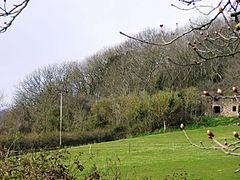Shiplate Slait facts for kids
| Site of Special Scientific Interest | |
 |
|
| Area of Search | Avon |
|---|---|
| Coordinates | 51°18′21″N 2°54′44″W / 51.30586°N 2.91232°W |
| Interest | Biological |
| Area | 33.9 hectares (0.339 km2; 0.131 sq mi) |
| Notification | 1987 |
Shiplate Slait is a special natural area in North Somerset, England. It covers about 33.9 hectares, which is like 84 football fields. This place is important because it's a Site of Special Scientific Interest (SSSI).
An SSSI is a protected area where plants, animals, or rocks are very unique. Shiplate Slait was made an SSSI in 1987. It's located near the village of Loxton, within the beautiful Mendip Hills.
Contents
What Makes Shiplate Slait Special?
Shiplate Slait is important for its rare plants and interesting geology. It also has ancient history, with burial mounds from thousands of years ago.
Rocks and Land
The ground at Shiplate Slait is made of different types of rock. These include Limestone and Dolomite. These rocks formed a very long time ago, during the Carboniferous period. This period was about 359 to 299 million years ago.
There are also younger rocks from the Triassic period. This was about 252 to 201 million years ago. These rocks are found at the lower edges of the site.
Amazing Plants
Shiplate Slait is home to special types of grassland. This grassland has not been changed by farming or building. It's called "calcicolous grassland" because it grows on chalky or limy soil.
Rare Plant Species
You can find some very rare plants here. These include:
- Koeleria vallesiana, also known as Somerset hair-grass.
- Carex humilis, which is a small plant called dwarf sedge.
- Potentilla tabernaemontani, known as spring cinquefoil.
These plants are important because they are not found in many other places in the country.
Ancient History
Shiplate Slait is not just about nature; it also has a rich past. There are ancient burial mounds here. These mounds are called bowl barrows.
Burial Mounds
A bowl barrow is a round mound of earth built by people long ago. They were used as burial sites. The barrows at Shiplate Slait date back to the Neolithic and Bronze Age periods.
The Neolithic period was around 4,500 to 2,500 BC. The Bronze Age followed, from about 2,500 to 800 BC. One of these barrows is about 24 meters wide and 1.2 meters tall. These ancient sites are protected as ancient monuments.

